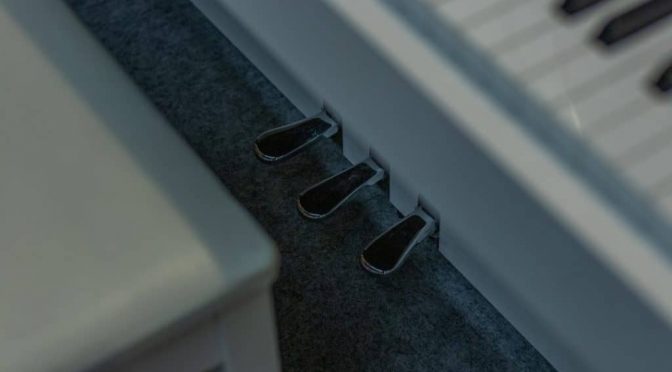Piano Blog by Skoove – Piano Practice Tips
Have you ever looked under your piano and seen those three brass colored levers sticking out from the bottom? On an acoustic grand or upright or piano, those are the pedals! Have you ever wondered what piano pedals do?
The pedals are an extremely important component to the piano. The pedals on the piano help to enrich the sound by making notes sustain longer than normal or by accentuating the softer dynamics and consequently enhancing the emotional impact of your music. Learning what piano pedals do is a necessary step on every pianist’s journey.
Sustain pedal
The first pedal we will learn about is called the sustain pedal or damper pedal. These two words are often used interchangeably to refer to the same pedal. On all acoustic grand or upright pianos, the sustain pedal is on the right side.
If you are close to your piano, and you have never pushed down this pedal, go over to your piano, press down the sustain pedal lightly with your foot, and play some keys. What happens?
The sustain pedal causes notes to sustain for a period of time after you lift your finger off the keys. This pedal on the piano adds a legato effect to your music, helps connect notes and chords together, and smoothen out transitions. It also adds a pleasant blurriness to your music, similar to the impressionism of a watercolor painting. However, too much sustain pedal can cause your music to become muddy and create indistinguishable sounds, so you must learn how to wield its power to your advantage.

The internal mechanics
Have you ever taken a look inside your acoustic piano? If not, take a moment and open the lid and examine the interior. Pretty cool, right? Have you ever wondered what are the pedals on a piano for? When you depress the sustain pedal, the little blocks of felt called “dampers” are lifted away from the strings. The dampers are what mute the piano strings after you lift your finger off the keys. This is why the sustain pedal is sometimes called the damper pedal.
To use the pedal correctly, place your right foot in front of the pedal, heel firmly on the floor, toes on the pedal lever. Your heel should remain on the floor as you pedal, keeping your foot in place. Maintaining proper piano sitting posture is important. Only your toes move up and down to work the pedal. How hard you have to press on the pedal varies from one piano to another. It is a bit like driving – every car feels a little bit different.
Try some practice
A great Skoove song to practice pedaling with is “Valse d’Amelie”. Use the damper pedal here to create a sense of reflection. Start by changing the pedal on the first beat of every measure. Aim to take the pedal off and put it down again just as you strike the new notes. In other words, it’s a swift up-and-down action. Be careful not to take the pedal off on beat three, but hold it almost to the downbeat.
There is an old saying, “pedal with your ears”. Make sure you are listening carefully to how your pedalling sounds. If the notes are too blurry, you may not be lifting your foot high enough to refresh the sound, or you might be forgetting to change the pedal. If the notes are not blending, you may need some more pressure on the pedal. It takes practice to get it right and for it to feel and sound effortless.
Skoove has many great lessons like the one mentioned above. If you are interested in checking it out more, you can sign up for a 7 day free trial. Skoove features over 400 lessons and a unique AI system that listens and responds to your playing in real time. It is awesome for students at any stage of life.
The pathway to pianissimo
Have you ever seen the dynamic marking pp? This dynamic means pianissimo, or extremely soft. This dynamic is best achieved by pressing the soft pedal or the una corda pedal. On an acoustic piano, this is the pedal on the left side.
This pedal operates differently on a grand piano versus an upright piano. On a grand piano, depressing the soft pedal shifts the piano hammers to the right so that the hammers only strike one string instead of two or three. The result is a softer tone. This is where the name una corda (one string) comes from. On an upright piano, pushing the soft pedal moves the hammers closer to the strings, thereby limiting the total distance the hammers can travel to strike the strings. This has a similar, muting effect.
The soft pedal is a beautiful, if fragile, sound. Anytime you see the dynamic markings pp, pianissimo, or una corda, you are being instructed to use this pedal. You will find this pedal quite a bit in the piano music of French composer Claude Debussy and you can practice using the soft pedal on Skoove’s arrangement of the traditional tune “Greensleeves”.
What does the middle pedal on a piano do?
The middle pedal can have three different functions, depending on the type of piano you have: the sostenuto pedal, bass damper pedal, or practice pedal.
Sostenuto pedal
The sostenuto pedal sustains only the notes that are held when the pedal is pressed. Any notes pressed after the pedal will sound as they normally would without the pedal. This applies to the entire range of the piano.
If you play a big chord high up on the piano and engage the sostenuto pedal with it, then the following notes will sound detached from the sustained chord, until you release the pedal.
Damper pedal
The middle pedal may also be a bass damper pedal. This pedal functions like the damper pedal on the right side, but only affects the bass notes. Any notes above middle C sound like normal.
Practice pedal
The third type of middle pedal is called the practice pedal. This type of pedal is most often found on a modern upright piano. Practice pedals soften the sound and lock into the down position so you do not have to sit there and hold it the entire time you practice. This pedal allows you to practice quietly meaning you will not annoy your neighbors or housemates and is especially useful if you live in an apartment or other close dwelling. Now you know what the middle pedal on a piano does!
What is pedal notation?
Now that you know what the pedals on a piano are for, it is time to learn how the pedals on the piano are notated. You will commonly see notation for the sustain and soft pedals, but rarely if ever for the middle pedal.
Notating the damper pedal
Pedal notation is easy to recognize. The notation for the sustain or damper pedal looks like this:

This example begins with middle C on the piano. The indication Ped tells you to play the sustain pedal, the extended horizontal line across the first measure means hold the sustain pedal down, the triangle at the beginning of the second measure means to refresh the pedal, and finally the vertical line at the end of the second measure means lift the pedal for good. Simple, right?
You may also see this notation:

Ped. simile means to continue the pedalling in the same manner. In this example, that means refreshing the pedal before the start of each new measure.
Notating the soft pedal
Notation for the soft pedal is achieved with either the dynamic marking pp meaning pianissimo or very quiet, or the dynamic marking una corda, meaning one string. Here is an example:

If you see a marking like this in music, it means these chords should be played with the soft pedal depressed. You can try using the sostenuto pedal with some basic piano chords as well.
Feeling left out in a digital world?
You may be wondering what to do now if you have a digital keyboard that did not come with any pedals? What are the pedals on the piano for if you don’t have any pedals to begin with? Many digital upright pianos come with a standard three pedal arrangement like acoustic pianos, but many keyboards do not.
However, most keyboards come equipped with a ¼” input jack on the back that is usually labeled “sustain.” If you are interested, you can purchase a stand-alone sustain pedal for a reasonable price and incorporate that into your practice. Unfortunately, there are not analogous soft and sostenuto pedals for digital keyboards.
But, digital keyboards have a different advantage: you can explore the wide world of guitar and bass effects pedals! Delay pedals, reverb pedals, fuzz, overdrive, and octave pedals, and more! If you are curious, there is truly no end to the sounds you can explore down that pathway with pedals on the piano!
Try out your free trial of Skoove today!
Author of this blog post:

Roberta Wolff started piano lessons at the age of five and is still enjoying learning! Currently, she teaches piano pedagogy and performance pedagogy at post graduate level in the UK. Her other work includes running a private teaching practice for students of all ages and abilities and creating learning and practice resources. Roberta loves writing as a means to supporting others on their piano journey.
Read More
This article is from an external source and may contain external links not controlled by Empeda Music.

